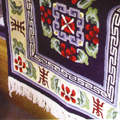The craft of weaving wool is a characteristic of the hills of Uttarakhand, initiated by the women of the villages. This craft has become indivisible from the lives of the natives, the Bhotias and the Gadvalis, even though the craft only took roots in the region just 3-4 generations back. Earlier a few nomadic tribes undertook the task of weaving woolen carpets, however now many more people have taken to the craft, and are weaving a variety of products.
Many organizations have set about the task of teaching weaving and setting up looms to help the craft prosper.
When talking about the craft, woolen carpets of the Bhotia are the most famous and the oldest form of the craft. Bhotias are a Tibetan nomadic tribe in Uttarakhand. Their winter months are spent in Dhunda, in an effort to obtain wool and weave fabrics while the summer months are spent in Harsil, growing beans, potatoes, apples and almonds. The charge of rearing sheep and procuring and preparing the wool is taken up by the tribe itself. September to October is considered to be the business time.
Traditionally yarn is spun on the spinning wheel or the Charkha, after which it is ready to be knitted or woven. Two types of looms are taken in to use while weaving. For the coarser wool an upright loom is used while for finer wool the pit loom is used. Knitting, done with a pair of needles has attained a different level of fabric construction altogether with the motifs transforming into three dimensional textures. Sheep wool is often mixed with rabbit hair to attain extra softness, shimmer and whiteness to the weave. Once the fabric is made, it is washed and brushed to give a felt like effect.
As a result of the blending of white and black wool in definite ratios, before spinning of the yarn, different shades of grey in the woolen fabrics area naturally obtained.
Tibetan motifs which have a higher demand, has replaced the traditional Bhotia designs. The designs can be characterized by two broad categories, stylized geometric motifs and the floral and dragon designs exhibiting a Chinese influence.
While many carpets are woven from memory, typically the design is followed by looking at the reverse of a finished carpet or from a colour graph.
Bhotias sell their woolen products at annual fairs at Bageshwar, Jaulgibi and Thal. The Tibetan carpets have a popular international market too.
Popular products made the Bhotias are knitted Kangsuk (socks), Saai (cap), Laakshu (glove), mufflers and woven suit lengths, shawls, dan (carpet), stoles, dumkar (banket) and paagad (belts).
YOUR VIEWS
PRACTITIONERS: INDIA
Access 70,000+ practitioners in 2500+ crafts across India.
BIBLIOGRAPHY
10,000+ listings on arts, crafts, design, heritage, culture etc.
GLOSSARY
Rich and often unfamiliar vocabulary of crafts and textiles.
SHOP at India InCH
Needs to be written.






